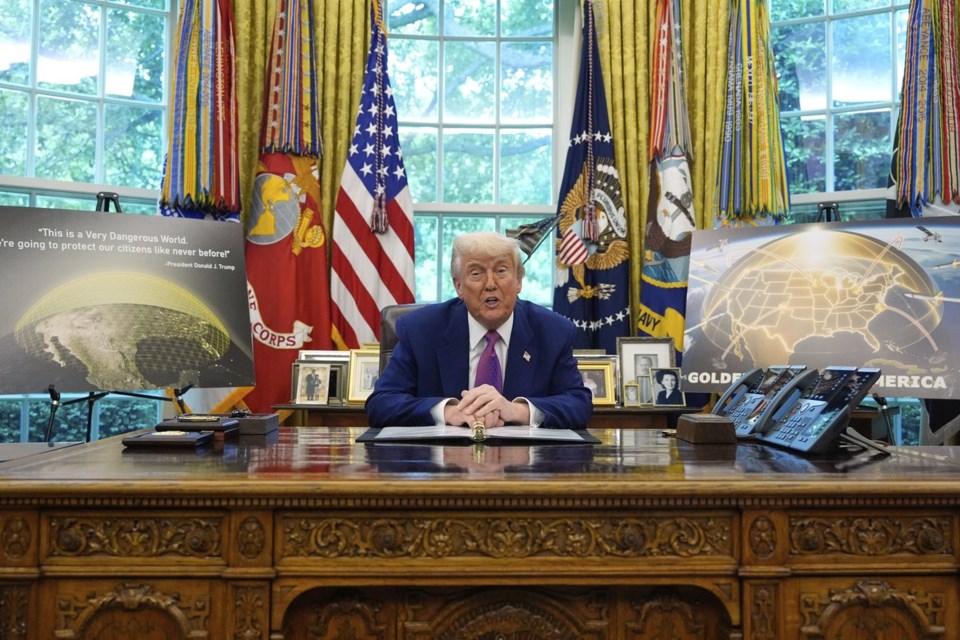WASHINGTON (AP) — President Donald Trump has announced the concept he wants for his future Golden Dome missile defense program — a multilayered, $175 billion system that for the first time will put U.S. weapons in space.
Speaking Tuesday from the Oval Office, Trump said he expects the system will be “fully operational before the end of my term," which ends in 2029, and have the capability of intercepting missiles “even if they are launched from space.”
It's likelier that the complex system may have some initial capability by that point, a U.S. official familiar with the program said.
Trump, seated next to a poster showing the continental U.S. painted gold and with artistic depictions of missile interceptions, also announced that Gen. Michael Guetlein, who currently serves as the vice chief of space operations, will be responsible for overseeing Golden Dome's progress.
Golden Dome is envisioned to include ground- and space-based capabilities that are able to detect and stop missiles at all four major stages of a potential attack: detecting and destroying them before a launch, intercepting them in their earliest stage of flight, stopping them midcourse in the air, or halting them in the final minutes as they descend toward a target.
For the last several months, Pentagon planners have been developing options — which the U.S. official described as medium, high and “extra high” choices, based on their cost — that include space-based interceptors. The official spoke on condition of anonymity to detail plans that have not been made public.
The difference in the three versions is largely based on how many satellites and sensors — and for the first time, space-based interceptors — would be purchased.
The Congressional Budget Office estimated this month that just the space-based components of the Golden Dome could cost as much as $542 billion over the next 20 years. Trump has requested an initial $25 billion for the program in his proposed tax break bill now moving through Congress.
The Pentagon has warned for years that the newest missiles developed by China and Russia are so advanced that updated countermeasures are necessary. Golden Dome's added satellites and interceptors — where the bulk of the program's cost is — would be focused on stopping those advanced missiles early on or in the middle of their flight.
The space-based weapons envisioned for Golden Dome “represent new and emerging requirements for missions that have never before been accomplished by military space organizations,” Gen. Chance Saltzman, head of the U.S. Space Force, told lawmakers at a hearing Tuesday.
China and Russia have put offensive weapons in space, such as satellites with abilities to disable critical U.S. satellites, which can make the U.S. vulnerable to attack.
Last year, the U.S. said Russia was developing a space-based nuclear weapon that could loiter in space for long durations, then release a burst that would take out satellites around it.
Trump said Tuesday that he had not yet spoken to Russian President Vladimir Putin about the Golden Dome program, “but at the right time, we will,” he told reporters at the White House.
There is no money for the project yet, and Golden Dome overall is “still in the conceptual stage,” newly confirmed Air Force Secretary Troy Meink told senators during a hearing Tuesday.
While the president picked the concept he wanted, the Pentagon is still developing the requirements that Golden Dome will need to meet — which is not the way new systems are normally developed.
The Pentagon and U.S. Northern Command are still drafting what is known as an initial capabilities document, the U.S. official said. That is how Northern Command, which is responsible for homeland defense, identifies what it will need the system to do.
The U.S. already has many missile defense capabilities, such as the Patriot missile batteries that the U.S. has provided to Ukraine to defend against incoming missiles as well as an array of satellites in orbit to detect missile launches. Some of those existing systems will be incorporated into Golden Dome.
Trump directed the Pentagon to pursue the space-based interceptors in an executive order during the first week of his presidency.
___
Associated Press writers Seung Min Kim and Michelle L. Price in Washington contributed reporting.
Tara Copp, The Associated Press



